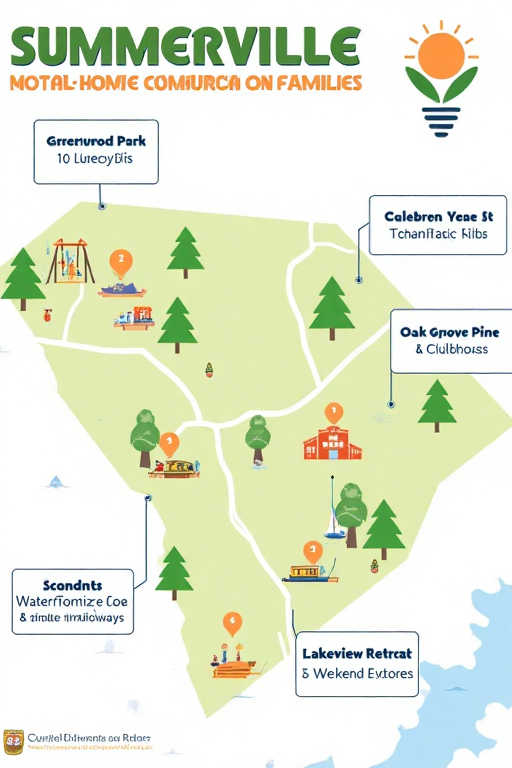Preparing Your Mobile Home for the Coastal Climate in Hilton Head, SC
Expert Guidance from Faith Mobile Home Solutions
1. Introduction
Hilton Head’s coastal environment brings sun-soaked days, salt-laden air, high humidity, and occasional storms. For mobile homeowners, these elements can accelerate wear, rust, and moisture damage. Faith Mobile Home Solutions presents this guide to help you take proactive steps in weatherproofing, maintenance, and energy efficiency, ensuring your home remains resilient and comfortable year-round.
2. Understanding the Coastal Climate
2.1 Temperature & Humidity
Average daytime highs range from 60°F in winter to 90°F in summer, often coupled with 70%–80% humidity. High moisture levels can lead to mold, mildew, and wood rot if not managed properly.
2.2 Hurricane & Storm Risks
June through November brings tropical storms and hurricanes. Peak season requires special preparations to secure your structure and belongings against wind and water damage.
2.3 Salt Air & Corrosion
Salt particles carried by coastal breezes accelerate rust on metal components and etch exterior surfaces. Regular washing and protective coatings are essential.
2.4 UV Exposure
Intense UV rays can fade paint, weaken plastics, and degrade roofing materials. UV-resistant products extend lifespan and maintain appearance.
3. Weatherproofing Roof & Exterior
3.1 Roof Inspection & Repairs
Inspect seams, vents, and flashing twice yearly. Replace cracked sealant and damaged shingles to prevent leaks.
3.2 Sealants & Flashing
Use marine-grade sealants around windows, doors, and vents. Ensure flashing is installed under siding edges to divert water.
3.3 Skirting & Underbelly Protection
Install vinyl or metal skirting with vents to protect the undercarriage from wind-driven rain and pests while allowing airflow.
4. Moisture & Mold Prevention
4.1 Ventilation Strategies
Maintain open ridge vents and soffits. Use exhaust fans in kitchens and baths to expel humid air directly outside.
4.2 Dehumidifiers & Desiccants
Place dehumidifiers in crawl spaces and basements. Silica gel packs in closets help protect fabrics and papers from mold.
4.3 Insulation Upgrades
Replace old insulation with foam or spray-in options rated for humid climates—reducing condensation and energy costs.
5. Hurricane & Storm Preparedness
5.1 Tie-Down Systems
Secure your home to its foundation with hurricane straps or turnbuckles rated for local wind speeds.
5.2 Storm Shutters & Impact Windows
Install shutters or impact-rated window panels to shield glass and siding from flying debris.
5.3 Emergency Supplies & Plan
Stock flashlights, water, nonperishables, and first-aid kits. Create and share evacuation routes and family communication plans.
6. Corrosion Prevention
6.1 Exterior Metal Coatings
Apply corrosion-resistant primers and marine-grade paints to metal awnings, railings, and hardware.
6.2 Hardware & Fastener Care
Lubricate hinges and locks with silicone spray. Replace rusty screws with stainless-steel alternatives.
6.3 HVAC & Plumbing Care
Flush AC coils and clean filters quarterly. Inspect copper plumbing for green patina and apply protective coatings.
7. Pest & Wildlife Control
7.1 Termite & Ant Prevention
Use borate-treated wood and perimeter insect barriers. Inspect annually for mud tubes and frass.
7.2 Rodent Exclusion
Seal gaps around pipes and vents. Install mesh guards on crawlspace vents to deter rodents.
7.3 Drainage & Gutters
Clean gutters biannually. Ensure downspouts direct water at least 5 feet from the foundation.
8. Insulation & Ventilation
8.1 Attic & Underfloor Insulation
Add closed-cell spray foam or rigid foam boards to reduce heat gain and moisture infiltration.
8.2 Roof Ventilation
Install ridge vents and soffit vents to promote continuous airflow and prevent attic heat buildup.
8.3 HVAC Servicing
Schedule professional AC tune-ups each spring to maintain efficiency and prevent moisture issues.
9. Interior Protection & Décor
9.1 UV-Resistant Treatments
Apply window films to block 99% of UV rays, protecting furnishings and reducing glare.
9.2 Moisture-Resistant Flooring
Choose vinyl plank or ceramic tile in wet areas to avoid warping and staining.
9.3 Coastal Décor Materials
Opt for marine-grade fabrics and composite woods that withstand humidity and salt air.
10. Energy Efficiency & Comfort
10.1 Energy-Star Appliances
Upgrade to Energy-Star refrigerators and HVAC units to lower utility bills in high-demand months.
10.2 Smart Thermostats
Use programmable or smart thermostats to optimize cooling schedules and monitor humidity.
10.3 LED Lighting & Fans
Install LED fixtures and ceiling fans with reversible blades to enhance comfort and reduce energy use.
11. Seasonal Maintenance Schedule
11.1 Spring
- Inspect roof, flashing, and seals
- Clean gutters and downspouts
- Service AC and replace filters
11.2 Summer
- Wash exterior to remove salt residue
- Check tie-down tension and fasteners
- Test dehumidifiers and ventilation
11.3 Fall
- Clear landscaping debris
- Inspect insulation and weatherstrip
- Stock emergency supplies
11.4 Winter
- Review evacuation plans
- Protect pipes and skirting vents
- Check window seals and caulking
12. Local Contractors & Resources
12.1 Coastal Home Specialists
Work with Beaufort County–licensed contractors experienced in coastal installations and codes.
12.2 Materials & Suppliers
Source marine-grade sealants and paints from Hilton Head Hardware and Coastal Supply Co.
12.3 Permits & Regulations
Consult Beaufort County Building Department for permit requirements on upgrades and tie-downs.
13. Frequently Asked Questions
1. How often should I inspect my roof?
Twice a year, ideally in spring and fall, and after major storms.
2. What sealant works best near salt air?
Marine-grade polyurethane or silicone sealants resist salt corrosion and UV exposure.
3. Can I install hurricane straps myself?
Basic kits are DIY-friendly, but professional installation ensures correct tension and safety.
4. How do I prevent mold under the home?
Ensure proper ventilation, use a dehumidifier, and maintain skirting vents clear of debris.
5. Are window films effective?
Yes—UV films block up to 99% of UV rays and reduce heat gain significantly.
6. What insulation is best for humidity?
Closed-cell spray foam provides moisture barrier and high R-value in coastal settings.
7. How do I maintain my skirting?
Check for gaps every six months, repair cracks, and ensure vents remain unobstructed.
8. Can salt air damage HVAC units?
Yes—regular coil cleaning and protective coatings help prevent corrosion.
9. Do I need flood insurance?
If your lot is in a FEMA flood zone, flood insurance is required by lenders and prudent for protection.
10. How to secure outdoor furniture?
Use heavy-duty anchors or store furniture indoors ahead of storm warnings.
11. What paint resists UV fading?
High-quality exterior acrylic paints with UV inhibitors maintain color longer.
12. How do I test skirting vents?
Shine a flashlight under the skirt—if light passes through, vents are clear; if not, clear debris.
13. What termite prevention works best?
Borate treatments and perimeter bait stations deter infestations in humid climates.
14. Can I use weatherstrip tape outdoors?
Self-adhesive foam tape is effective around doors and windows but must be UV-rated.
15. How often to service AC?
At least once a year, ideally before summer peak usage.
16. Are dehumidifiers necessary?
In high-humidity months, they help prevent mold and protect furnishings.
17. How to clear gutters safely?
Use a sturdy ladder and scoop tool; consider gutter guards to reduce debris buildup.
18. What flooring suits coastal climates?
Luxury vinyl plank and ceramic tile resist moisture and salt exposure.
19. Should I install storm shutters?
Yes—they offer best protection for windows and sliding doors in storms.
20. How to prepare for winter storms?
Inspect tie-downs, clear drains, and store loose items before cooler, windy months.
21. Can coastal décor withstand humidity?
Choose marine-grade fabrics, treated woods, and moisture-resistant paints.
22. How to find Beaufort County codes?
Visit the Beaufort County Building Department website for up-to-date regulations.
23. What are common contractor costs?
Simple sealant jobs start at $200; full storm-prep packages range $1,000–$3,000.
24. How do I monitor humidity?
Use a hygrometer in crawlspaces and living areas; aim for 40%–60% indoor humidity.
25. Who to call for coastal expertise?
Contact Faith Mobile Home Solutions at (843) 555-1234 for personalized advice and referrals.
14. Additional Keywords
- coastal mobile home preparation Hilton Head SC
- weatherproof mobile home Hilton Head
- humidity control mobile home SC
- hurricane readiness Hilton Head mobile home
- salt air corrosion prevention
- UV resistant mobile home treatments
- skirting protection coastal homes
- ventilation strategies for mobiles
- dehumidifier for coastal home
- marine-grade sealant mobile home
- tie-down systems for manufactured homes
- storm shutters installation SC
- attic insulation mobile home SC
- Energy-Star HVAC coastal
- smart thermostat for humidity
- rodent exclusion mobile home
- termite prevention coastal SC
- gutter maintenance Hilton Head
- coastal décor moisture resistant
- marine-grade exterior paint SC
- local coastal contractors Hilton Head
- Beaufort County mobile home codes
- mobile home skirting vent solutions
- luxury vinyl plank humidity
- Faith Mobile Home Solutions coastal tips




